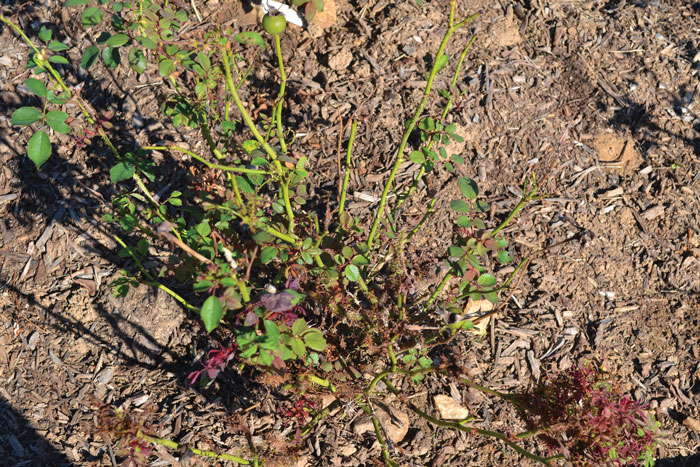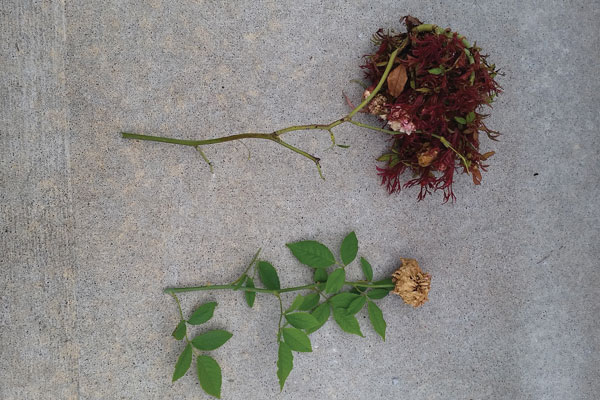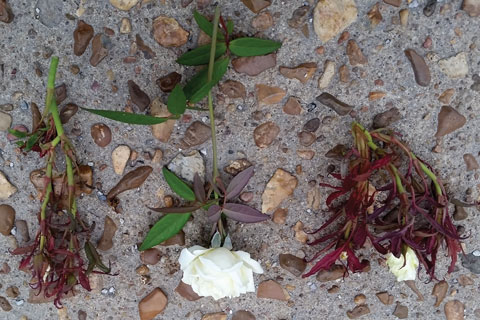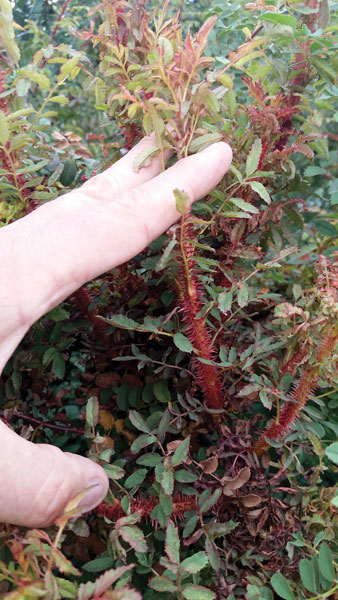4/1/2019
Getting Rid of Rose Rosette Disease
Jennifer Zurko

Shakespeare’s Juliet may have waxed poetic on comparing the sweetness of a rose to the curse of the Montague name, but the Phyllocoptes fructiphilus mite thinks roses are delicious.
Pictured: An infected rose plant in the landscape. Photo courtesy of Star Roses and Plants.
And not just a specific hybrid—all rose types have been found to be hosts to this mite, which is the cause of the dreaded Rose Rosette Disease (RRD). Other than the ubiquitous boxwood (which has its own problems, see page 40), yews and arborvitaes, roses are a mainstay in landscapes all over North America. (Estimates for the rose bare root and container market total close to a $400 million business.) And once RRD sets in, it can kill a rose plant within two to three years.
So the need to study and try to eradicate RRD is so great that, in 2014, the USDA’s National Institute of Food & Agriculture (NIFA) granted more than $4 million dollars in funding to an elite team of university researchers, breeders, entomologists and others to come up with solutions to stop the tide of dying roses around the country.
RRD was first diagnosed in the 1940s, but it didn’t become an epidemic until about seven years ago, said Michele Scheiber, who’s Director of Research at Star Roses and Plants.
“There are more roses planted en masse now than there used to be,” she said, explaining why RRD has recently become a significant problem. “In the ’70s and ’80s, people were planting mostly hybrid teas; now you see more shrub roses. But no rose is immune to Rose Rosette, especially among the commercial varieties.”
RRD has been seen in most areas of the U.S., with specific parts showing up as hot spots in certain years. Michele said that this year she’s seen it in the Dallas area, but the disease tends to be “more East Coast-centric.” The Deep South hasn’t yet had a major brush with RRD, which makes some researchers wonder if it’s just too hot for the mites. The studies of that hypothesis are ongoing.
So far, trials have shown that some wild rose species—like R. rugosa, R. folialosa, R. palustris, R. arkansana and R. virginiana—have far more resistance to RRD and breeders have been feverishly working on trying to figure out how they can put that into the commercial cultivars that are so susceptible, which takes years.
In the meantime, the Rose Rosette Team is continuing their research on the biology of the P. fructiphilus mite, along with figuring out possible new control methods, discovering resistant hybrids and educating growers, landscapers and consumers.
Researching Ways to Combat RRD
The rest of this article was compiled from reports based on research from some of the members of the Specialty Crop Research Initiative Project Combating Rose Rosette that was funded by the USDA:
• David H. Byrne (Project Director), Department of Horticultural Sciences, Texas A&M University
• H. Brent Pemberton, Texas A&M AgriLife Research and Extension Center
• Kevin Ong, The Texas Plant Disease Diagnostic Laboratory, Texas A&M AgriLife Extension
• Mark Windham, Department of Entomology and Plant Pathology, The University of Tennessee
• Jennifer Olson, Department of Entomology and Plant Pathology, Oklahoma State University
RRD is incited by a negative-sense RNA virus (genus Emaravirus), which is vectored by a wind-dispersed eriophyid mite (P. fructiphilus). Symptoms on roses include “witches broom”/rosette type growth, excessive thorniness, and discolored and distorted growth. Unlike most other rose diseases, RRD usually results in plant death.
Since being identified in the western United States and Canada, it has spread east with the aid of Rosa multiflora, a naturalized rose species host, and has become widespread from the Great Plains to the East Coast of North America. This epidemic has spread to garden roses in home and commercial landscapes where losses have been high.
 The popularity of landscape roses in gardens has increased greatly in recent years, resulting in widespread use of this type of rose in both home and commercial landscapes. This and the occurrence of the disease in poorly managed landscapes where plants aren’t scouted and rogued have no doubt contributed to the spread of this deadly disease. The degree of plant loss threatens the use of garden roses by consumers and the rose production industry itself.
The popularity of landscape roses in gardens has increased greatly in recent years, resulting in widespread use of this type of rose in both home and commercial landscapes. This and the occurrence of the disease in poorly managed landscapes where plants aren’t scouted and rogued have no doubt contributed to the spread of this deadly disease. The degree of plant loss threatens the use of garden roses by consumers and the rose production industry itself.
Pictured: One of the symptoms of RRD is the appearance of “witches broom”—rosette-type growth—on new shoots. Photo courtesy of David Byrne.
Since it was confirmed that the eriophyid mite was the vector of RRD in the late 1980s, three players in this disease epidemic are described: the virus pathogen, the mite vector and the reservoir of a host plant. Of interest is the fact that the RRD epidemic wasn’t caused by the introduction of a causal disease agent or even a vector for the virus, both of which are endemic to North America. What assisted the spread of this disease from the west to the east of the continent was the reservoir of naturalized stands of a very susceptible host plant (R. multiflora) that was introduced across a large geographical area for an entirely different purpose.
As a result of the RRD epidemic in North America and its effects on national production and consumer markets for roses, a research proposal to study this disease was funded by the Specialty Crops Research Initiative through the USDA. The proposal was developed in collaboration with the rose industry beginning with the Rose Rosette Conference organized by Star Roses and Plants and the Garden Rose Council in April of 2013. Over a period of months, a research and extension team that involved plant pathologists, rose breeders and geneticists, molecular geneticists, an entomologist, agricultural economists, marketing experts and extension personnel was developed to tackle RRD. Thus, this project and its objectives are industry driven and initiated.
 Healthy rose stem with flower in the middle of RRD-affected stems on the left and right. Photo courtesy of David Byrne.
Healthy rose stem with flower in the middle of RRD-affected stems on the left and right. Photo courtesy of David Byrne.
The goals of this project are to develop and promote the use of sustainable Best Management Practices to manage RRD; to identify additional sources of RRD resistance; to develop the molecular tools to quickly incorporate RRD resistance and other important traits into elite rose germplasm; and develop strategies to overcome market barriers to the use of sustainable rose cultivars and increase rose sales. This will lead to well-adapted, long-lived landscape roses, which need little care and minimal agricultural chemicals for their production and use in the garden.
Producers and breeders benefit from long market-life cultivars through increased returns for product investment. The breeding tools and approaches developed in this project will benefit breeders and producers by allowing quicker development of RRD-resistant and adaptable cultivars. And marketing and educational information obtained in this project will better direct the breeders and nurseries on what product is most highly desired, leading to better products for consumers and increased sales and profits of roses.
Some of the projects funded include:
• Exploring new diagnostic techniques—The group developed and validated an improved real-time polymerase chain reaction (PCR), a method used to determine presence of RRD, which is more reliable and provides results in as little as three hours, reducing the time for analysis by 50% compared to testing that was being used. We’ve also conducted work on isothermal DNA amplification technologies, electronic probes and lab-based antibody analysis to further facilitate the virus testing of roses.
• Chemical control methods—The application of miticides (bifenthrin, fenpyroximate, spiromesifen and spirotetramat) was found to be effective (one-week spray intervals) in preventing RRD symptom development. Ongoing work is determining the optimal spray interval (two-, four-, and six-week intervals with four previously mentioned miticides) and the effectiveness of additional miticides (abamectin and bifenazate on a two-week schedule) and a novel antiviral compound on mite populations and symptom development.
• Biological control methods—At the USDA, various predator mites (Neoseiulus spp. and a smaller mite Tydeus spp.) were observed on roses. At the University of Delaware, two species of predatory mites (Neoseiulus californicus and Amblyseius andersoni) were observed under a microscope interacting with P. fructiphilus on infected rose shoots with all of the leaves removed. Both mites readily consumed P. fructiphilus, indicating their potential as biocontrol agents. Future work will involve quantifying consumption of the eriophyids using a limited number of predators on rose shoots with the leaves intact, which will also indicate if the predators are of a suitable size to enter the refuges of P. fructiphilus.
• Other control methods—The frequent approach of controlling RRD in a garden was to eliminate the infected branch, which was ineffective as these plants frequently remained infected. More effective was the rapid bagging and rogueing of symptomatic plants and the use of non-host barriers, such as Miscanthus sinensis, which served to reduce the appearance of symptoms by more than 50%, presumably by blocking the spread of the vector mite.
 Pictured: Excessive thorniness is another symptom of RRD. Photo courtesy of David Byrne.
Pictured: Excessive thorniness is another symptom of RRD. Photo courtesy of David Byrne.
As there is a need to count the mites on plants and in the air, the mite count methodology was optimized. Initially, the methodology to count mites on plants was optimized using standard laboratory equipment which may cost more than $9,000. Since this is too expensive for nursery and landscape professionals, and homeowners who want to monitor mite levels to determine when to apply miticides as a part of their management protocol, a counting protocol/kit and handbook was developed with materials that were readily available that cost less than $100. The kit allows the user to use a smartphone to photograph the eriophyid mites they’re counting. Currently, these kits are being field-tested by nursery owners, professionals who maintain rose gardens and private garden owners.
• Breeding for resistant cultivars—In partnership with a number of rose breeders, the team has already made more than 15,000 hand pollinations that resulted in more than 20,000 hybrid seed for this project. The germination of the crosses, as is common with roses, was highly variable. Incorporating RRD resistance from these species into the cultivated rose is a long-term project. The first set of seedlings from the RRD populations were propagated and planted in replicated trials in Tennessee, Oklahoma and Texas. The second set of seedlings was propagated and planted in replicated trials in the spring of 2018. The third set will be planted in replicated trials in the spring of 2020 after additional funding for the project has been secured. Once the hybrids form the first set of flowers, backcrosses to the cultivated germplasm will begin.
• Communication to and assistance from the general public—Knowledgeable and enthusiastic “citizen scientists” are needed to collect quality data, so interested individuals were equipped with the knowledge to identify RRD to assist in efforts to seek and identify potential RRD-resistant roses, which included e-learning modules that were posted on the website roserosette.org (which was launched in 2017), along with fact sheets on RRD and some other rose diseases. The targeted demographic includes people who are interested in gardening and with a particular interest in roses. Targeted groups included Master Gardeners, rosarians and garden club members.
Roses are one of the most economically important ornamental plants in North America, so the findings from these studies will strengthen this industry and support the use of a sustainable and much loved plant by consumers across the continent. GT